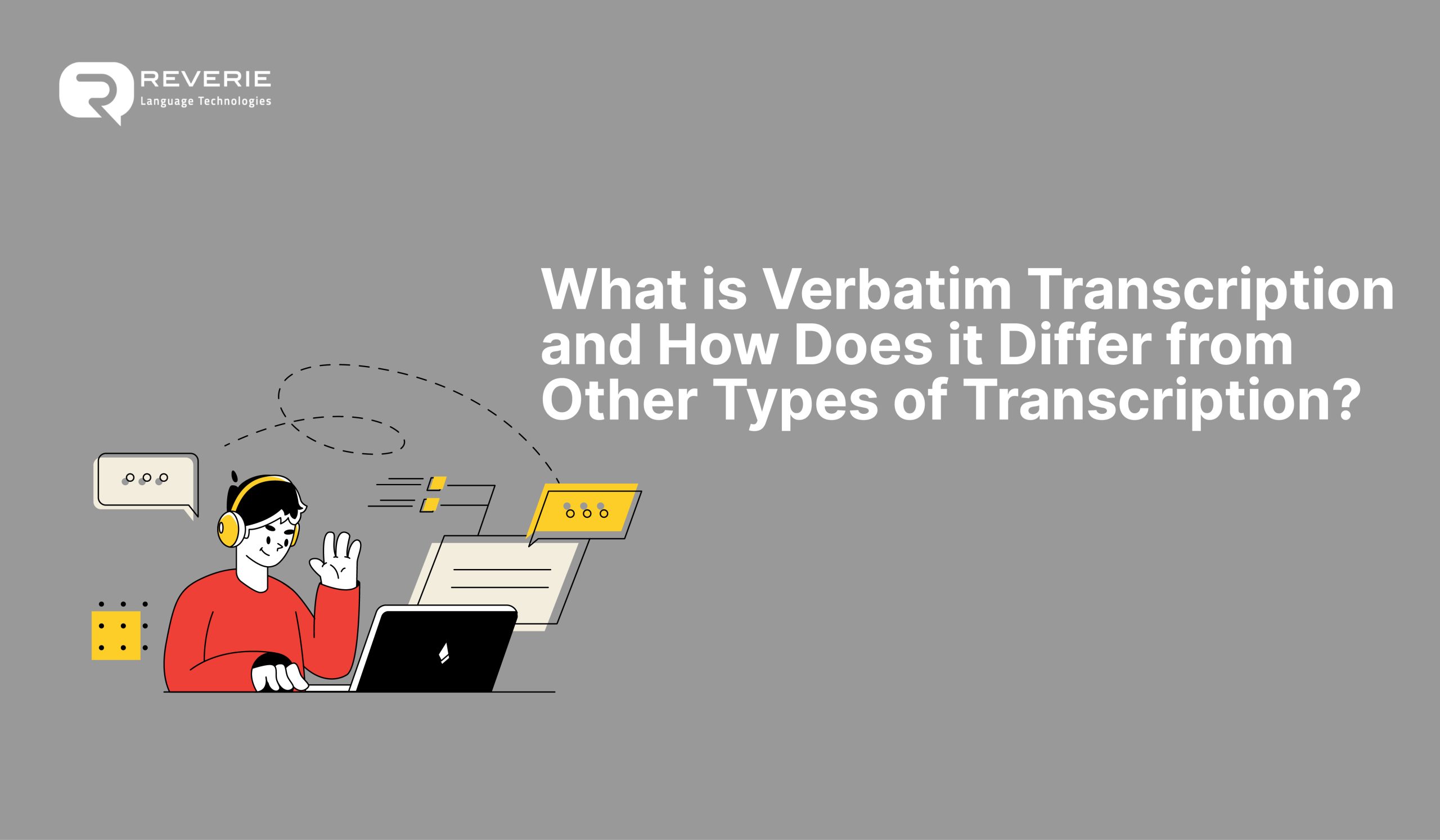Transcription transforms spoken content into actionable text, enabling businesses to analyse conversations, maintain records, and ensure accessibility. Verbatim transcription holds a distinct position in this domain. It goes beyond basic documentation, capturing every word, pause, and nuance with precision.
Industries like legal, healthcare, and media demand this level of detail to ensure accuracy, context, and compliance. As the reliance on transcription grows, understanding how verbatim transcription stands apart from other types is essential for making informed decisions. This article explores its significance, and differences from other methods, which will empower you to select the best transcription approach for your business needs.
Understanding Verbatim Transcription Definition: A Detailed Look
Verbatim transcription is the process of converting spoken content into text while preserving every detail of the conversation. It includes filler words, repetitions, pauses, stutters, and even non-verbal sounds like laughter or sighs. This method ensures no detail is overlooked, creating an exact textual representation of the audio.
- Verbatim or True Verbatim Transcription Example: “Uh, I think, um, we should, you know, proceed with the, uh, plan we discussed, right?”
- Non-Verbatim or Clean Verbatim Transcription Example: “I think we should proceed with the plan we discussed.”
The verbatim version maintains context and tone, which can be vital in situations like legal depositions or research analysis.
Benefits of Verbatim Transcription
When every word and pause in a conversation carries significance, verbatim transcription becomes invaluable. Following are some of the notable benefits of verbatim transcription:
- Captures Full Context: Verbatim transcription goes beyond words, capturing subtle elements like pauses, filler phrases, or even shifts in tone. These details often reveal more than what is explicitly said, such as hesitation or uncertainty in a deposition or focus group discussion.
- Delivers Insights Through Nuance: For researchers and businesses analysing communication patterns, verbatim transcription offers a wealth of qualitative data. With preserving every detail, it allows analysts to study speech patterns, emotions, and even cultural nuances, aiding in deeper insights.
- Facilitates Transparency and Reliability: With verbatim transcription, there is no room for misinterpretation. It creates an authentic record that can be referenced and verified, which is especially crucial in compliance-driven industries.
Follow These Rules of Verbatim Transcription for Perfection
Creating an accurate verbatim transcript requires meticulous attention to detail and adherence to specific guidelines. These rules ensure the final transcript is not only precise but also contextually rich. Following are the verbatim transcription rules that need to be followed:
- Capture Every Word Without Paraphrasing
A fundamental rule of verbatim transcription is recording every spoken word exactly as it was said. This includes all filler words like “um” and “uh,” false starts, repetitions, and grammatical errors. Avoid paraphrasing or rephrasing sentences, as this can alter the intended meaning.
- Include Non-Verbal Communication and Ambient Sounds
Verbatim transcription captures not just words but also non-verbal cues and environmental sounds. These details add depth and context to the transcript, helping readers understand the full scope of the interaction. Use brackets to denote such elements.
Example:
- “[Laughter] That was unexpected.”
- “The door creaks open [door opens].
- Note Fillers and False Starts
Fillers like “uh” and “you know” and false starts (sentences left incomplete) may seem irrelevant but provide valuable insights into the speaker’s emotions or state of mind. These must be included in the transcript to maintain authenticity.
Example:
- “I was planning to… I mean, I think it’s better if we wait.”
- Represent Pauses and Interruptions Accurately
Pauses, overlaps, and interruptions are integral to verbatim transcription, reflecting the natural flow of conversation. Use appropriate notations to mark pauses or when speakers interrupt one another.
Example:
- “So, I was saying… (3 seconds) we need to move forward with this.”
- Speaker A: “I believe this is–”
- Speaker B: “–the right approach to take.”
- Maintain Speaker Identification Consistently
For multi-speaker recordings, clearly label speakers and maintain consistency throughout the transcript. This is essential for readability and ensuring clarity in who said what.
See the Difference: Comparing Verbatim with Other Transcription Types
Not all transcription styles are created equal, and each serves a distinct purpose based on industry needs. The table below outlines the differences between different types of transcriptions, helping businesses select the right fit for their needs.
Aspect | Verbatim | Intelligent Verbatim | Edited | Phonetic |
Definition | Captures every word, filler, pause, and non-verbal sound like sighs, laughter, and stutters | Removes fillers, stammers, and repetitions while preserving the meaning of the message. | Polishes the transcript by correcting grammar, restructuring sentences, and removing unnecessary details. | Focuses on capturing pronunciation and sound using phonetic symbols, such as the International Phonetic Alphabet (IPA). |
Focus | Provides a complete, detailed record for context and emotional nuance. | Balances clarity and authenticity by removing irrelevant elements. | Ensures readability, professionalism, and flow for formal documentation. | Documents pronunciation accurately for linguistic and phonetic analysis. |
Advantages | Ensures no detail is missed, capturing intent, hesitation, and tone for deeper insights. | Improves readability while maintaining the original message’s essence. | Produces clean, professional documents suitable for publication or formal communication. | Preserves exact pronunciation for detailed phonetic or linguistic analysis. |
Challenges | Can be complex and time-consuming to analyse due to its exhaustive detail. | May omit subtle context or emotion by excluding fillers and hesitations. | Loses nuance, such as tone or hesitation, during refinement for readability. | Requires specialised skills to interpret and use effectively for analysis. |
Verbatim Transcription in Action: Key Use Cases
The verbatim transcription’s detailed approach meets the demands of industries that rely on precise, unaltered records to drive decisions and maintain accuracy.
Its approach serves diverse industries, that includes:
- Legal Proceedings: Legal professionals depend on verbatim transcription for court proceedings, depositions, and witness testimonies. Capturing every filler word, pause, or hesitation ensures that the full intent and tone of a statement are preserved, which is crucial for building strong legal arguments.
- Example: With legal verbatim transcription, a witness’s repeated hesitation or filler words may influence a case’s direction.
- Healthcare Documentation: Medical professionals rely on verbatim transcription for documenting patient records and physician notes. These transcripts ensure compliance and support accurate communication among healthcare providers.
- Example: A physician dictating treatment details benefits from the exact reproduction of their instructions.
- Market Research and Media: Researchers and journalists use verbatim transcription for interviews, focus groups, and content analysis. Preserving tone and nuance, it enriches qualitative insights and supports accurate reporting.
Example: A journalist conducting an interview can use a verbatim transcript to ensure quotes are precise and contextually accurate.
How Reverie's Speech-to-Text API Simplifies Transcription
Transcription can be time-intensive, but technology has redefined the process. Reverie’s Speech-to-Text API delivers a reliable solution, enabling detailed and scalable transcription workflows.
Know how Reverie’s API optimises transcription in the following:
- Enhanced Accuracy: The API leverages advanced AI models to transcribe audio files with precision, even in noisy environments. This ensures detailed records without compromising quality.
- Customisable Outputs: Reverie allows businesses to tailor transcriptions with features like speaker identification, timestamps and formatting options. This flexibility is especially valuable for industries needing organized and easily referenceable transcripts, such as legal or corporate sectors managing speech-to-text phone transcripts.
- Multi-Language Support: With robust language capabilities, the API addresses the needs of global businesses, making it versatile for multilingual transcription tasks.
- Seamless Integration: Businesses can easily integrate the API into their existing systems, streamlining transcription processes while maintaining efficiency and scalability.
Practical Uses of Speech-to-Text Solutions
- Customer Support: Generate accurate transcripts of phone calls for better service and training.
- Legal Documentation: Transcribe audio evidence or multi-speaker recordings with precision.
- Accessibility: Create real-time captions or post-event transcripts for accessibility compliance.
- Content Creation: Convert interviews or meetings into editable transcripts for publications or reports.
Your Next Step: Make Informed Transcription Choices
Verbatim transcription stands out for its ability to capture every detail of spoken communication, providing accuracy and context that other transcription types cannot match. Understanding its differences from other transcription methods empowers you to make informed decisions that suit your unique needs. Advanced tools like Reverie’s Speech-to-Text API simplify the process, offering scalable and accurate solutions for complex transcription needs.
Take action today—book a free demo and discover how verbatim transcription can enhance your workflows with unmatched accuracy and reliability.
Faqs
What are the different types of verbatim transcription?
Verbatim transcription is categorised into:
- True Verbatim: Captures every spoken word, filler, pause, and non-verbal sound like laughter or sighs, ensuring complete accuracy.
- Clean Verbatim: Focuses on the spoken words while removing filler words and irrelevant sounds for improved readability without losing the core message.
When should I use verbatim transcription for my business?
Use verbatim transcription when capturing precise details of conversations is essential. It is ideal for documenting legal proceedings, interviews, research data, and other scenarios where pauses, tone, and exact wording provide critical context for analysis or compliance.
What are the key verbatim transcription rules?
To write a verbatim transcript, the key rules include:
- Documenting every spoken word exactly as it appears, including fillers like “uh” or “um.”
- Including non-verbal sounds such as laughter, sighs, or background noises where relevant.
- Maintaining speaker identification for multi-speaker conversations.
- Using timestamps for accuracy in referencing specific parts of the audio.
What’s the difference between verbatim and non-verbatim transcription?
Verbatim transcription records every word, filler, and sound exactly as spoken, preserving all details for full context.
Non-verbatim transcription, by contrast, focuses on the core message, removing fillers, repetitions, and unnecessary elements to enhance readability while retaining the intended meaning.
Which is the best transcription service for my business?
The ideal transcription service depends on your needs. For precise, detailed records, True Verbatim transcription is best, especially for legal or compliance purposes. For high-volume or multilingual content, AI-powered tools like Reverie’s Speech-to-Text API offer scalability, accuracy, and customisation options such as speaker identification and timestamps.


